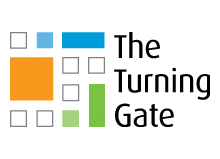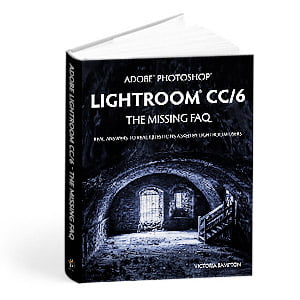The TTG CE4 Cart is a pretty versatile beast. You can use it to sell just about anything you want from prints, to books, to spaces at a workshop.
But setting up your products and pricing and shipping takes a bit of getting used to when you first start using the cart.
The idea is to first set up products that you offer for sale. Then create Pricing Schemes that reflect what you offer for sale and assigns pricing to them.
You do this by first creating “Products”. A prime example would be prints for sale.
The Products section of the TTG Cart has several fields to fill out.
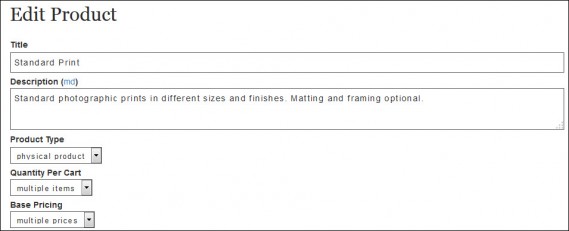 First is Title. This is pretty obvious. If you’re selling prints, the title can be simply “Prints” or “Standard Prints”. But wait, how many kinds of prints to you want to offer? Standard photo prints? Metal prints? Canvas wraps. It will probably best to create separate products for each of these.
First is Title. This is pretty obvious. If you’re selling prints, the title can be simply “Prints” or “Standard Prints”. But wait, how many kinds of prints to you want to offer? Standard photo prints? Metal prints? Canvas wraps. It will probably best to create separate products for each of these.
By the same token, you may have images in the standard camera aspect ratio (2:3), panoramic images, and square images. It may be best to have these as separate products. (Can you see your customers choosing a 25 x 25 inch image from a picture that has a 3:2 aspect ratio?). You can then assign a specific pricing scheme to a specific gallery (of, say, panoramas) or you can use these pricing schemes in galleries that use the “Mixed Pricing” option.
The next field is the Description field. Here you can be pretty elaborate on what you offer. Photographer Kristen Westlake uses this field to describe the specifics of her fine art gallery wraps, including framing options and a note about packaging and shipping.
Next is Product Type. This is self explanatory: Physical Product or Digital Download.
Quantity Per Cart. Do you want to be able to sell more than one of each to your customer?
Base Pricing. This is the tricky one. If you’re selling a product like a book or a mug, then use Single Price. But if you’re selling prints, you generally want to offer different sizes at different prices. So choose Multiple Pricing if this is the case.
Product Attributes
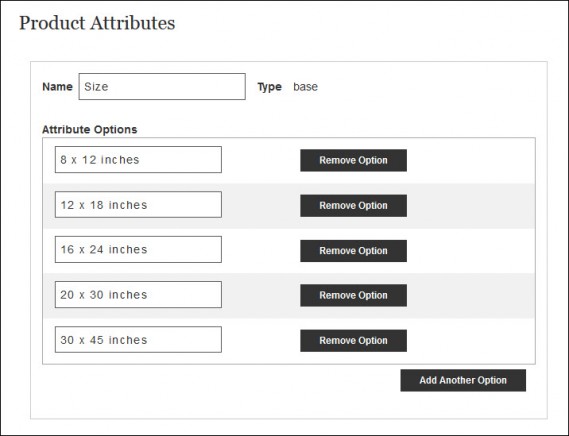 There is already one Attribute included for each product. Generally, if you’re selling prints, the first question you want to ask your customer is what size they’re looking for. So this first Attribute can be named “Size”.
There is already one Attribute included for each product. Generally, if you’re selling prints, the first question you want to ask your customer is what size they’re looking for. So this first Attribute can be named “Size”.
Each Attribute you create can have Options. Lots of options if you like. Options for the Size attribute would be some, well, sizes.
Other Attributes you can create might be photo finishing options, or matting and mounting options, or framing options.
You might want to think all this through and map it out on paper before diving in with the cart.
I use the cart to sell workshop spaces. I have Base Pricing set at “multiple prices” because I offer the option to pay the deposit or the full price.
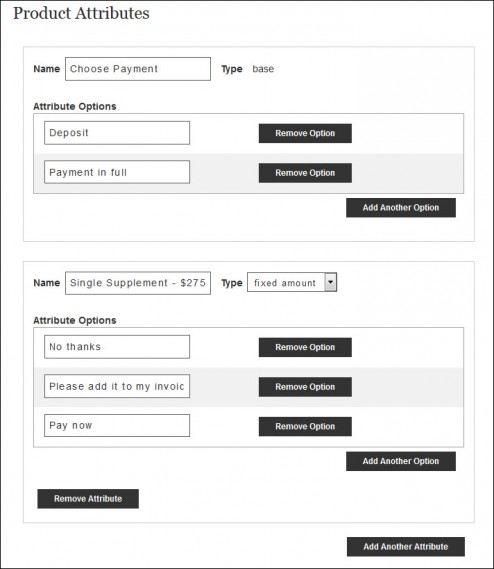 My first Product Attribute is “Choose Payment”. The options are “Deposit” and “Payment in Full”. When it gets close to the time that balances are due, I’ll often add that option to the “Choose Payment” attribute.
My first Product Attribute is “Choose Payment”. The options are “Deposit” and “Payment in Full”. When it gets close to the time that balances are due, I’ll often add that option to the “Choose Payment” attribute.
Another Attribute I’ll add for international photo tours where the price is based on double occupancy is “Single Supplement – $xxx”. The options I list are “No Thanks”, “Add to invoice”, and “Pay now”.
Once you’ve set up all the Attributes (size, finish, matting, framing) and Options (sizes, type of finish, etc.), click Save Product.
Go ahead and create other products as needed. If you wish to offer canvas or metal prints as well as standard prints, create products for those. If you offer panoramas or square prints, create those products too.
Pricing Schemes
The next step is to create pricing schemes so that you can actually sell your products. The Cart reads the pricing scheme you’ve set and then presents your customers with the products that you’ve assigned to that Pricing Scheme.
A pricing scheme can consist of one product or as many as all of the products you’ve created. For example, say you want to offer your customers a choice between Standard Print, Canvas Print, or Metal Print. When they choose one of those products, they’ll then be presented with the options associated with that product.
Create a Pricing Scheme by clicking on Pricing in the Cart Admin and choose Pricing Schemes.
Click on Add Pricing Scheme.
Give it a name (avoid using quote marks or special characters) and check the boxes for all the products you want associated with this scheme. From the example above, you’d select “Standard Prints”, “Canvas Prints”, and “Metal Prints”.
Use the drop-downs on the right to place the product in the order you wish them to be presented in the Add to Cart drop-down list.
Save the pricing scheme. (Note, sometimes you’ll need to click on Edit Products and apply the ordering again, just a quirk I run across sometimes).
 Once you save the pricing scheme you’ll be sent back to the main Pricing Schemes page. Notice the word “incomplete” highlighted in red next to the name of the pricing scheme you just created. (Note, if you don’t see any products listed, click Edit Products for that scheme, make sure the products are in the proper order, and save again).
Once you save the pricing scheme you’ll be sent back to the main Pricing Schemes page. Notice the word “incomplete” highlighted in red next to the name of the pricing scheme you just created. (Note, if you don’t see any products listed, click Edit Products for that scheme, make sure the products are in the proper order, and save again).
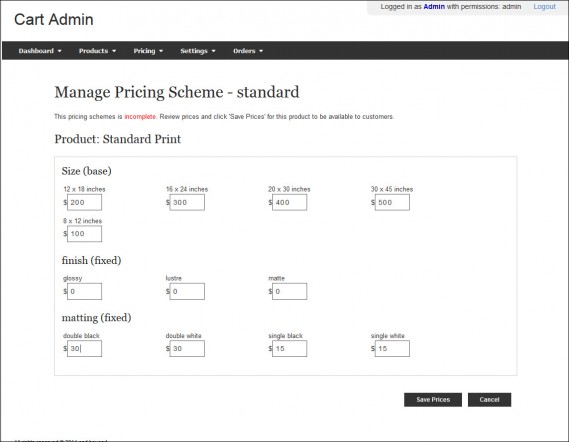 Click on Manage Pricing. In the screen presented, fill in all pricing fields.
Click on Manage Pricing. In the screen presented, fill in all pricing fields.
Once you’ve assigned and saved your pricing, go to the Cart menu and click on Pricing > Shipping and click on the Manages Charges link for each shipping method that shows “incomplete”. Set your shipping options for each product you’ve created. If you don’t do this, your cart will likely throw an error when customers try to buy something.
Good to know:
A Pricing Scheme can consist of more than one Product.
A pricing scheme that contains the same products as another scheme can assign different prices to those products.
Beyond setting up your products and pricing, you can also set up your galleries to use more than one pricing scheme via the Mixed Pricing option. For more on that, see the Mixed up About Mixed Pricing? post
